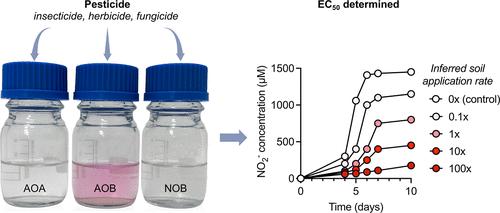Single Species In Vitro Assays with Nitrifying Bacteria and Archaea for Assessing the Toxicity of Pesticides on Soil Microorganisms
IF 11.3
1区 环境科学与生态学
Q1 ENGINEERING, ENVIRONMENTAL
引用次数: 0
Abstract
Single species tests on surrogate organisms from different trophic levels constitute a cornerstone in aquatic and terrestrial ecotoxicology, representing a major tool for assessing pesticide ecotoxicity. However, there are no assays approved under the EU regulatory framework that specifically target soil microorganisms, despite their pivotal role in ecosystems. This study evaluated the toxicity of pesticides on ammonia-oxidizing microorganisms (AOM), recognized as potential indicators of pesticide toxicity in soil, using a single species in vitro testing system. We assessed the toxicity of ten pesticides of major categories (insecticides, fungicides, herbicides) on a range of ammonia-oxidizing bacteria (AOB), ammonia-oxidizing archaea (AOA) and functionally associated nitrite-oxidizing bacteria (NOB) in liquid cultures, representing all major soil lineages of both groups. Toxicity end points (EC50) were calculated for each strain–pesticide combination. Nitrosotalea sinensis ND2, Nitrosospira briensis and Candidatus Nitrobacter laanbroekii NHB1 were the most sensitive AOA, AOB and NOB, respectively. Fungicides and insecticides were more toxic to AOM than NOB, whereas herbicides had a wide range of toxicity across all groups of nitrifiers. Our study introduces a novel testing approach that includes a range of phylogenetically and ecophysiologically distinct nitrifier strains for assessing pesticides toxicity on soil microorganisms that could potentially, upon standardization, serve as a tier I assay in environmental risk analysis.

硝化细菌和古细菌单种体外试验评价农药对土壤微生物的毒性
对不同营养水平的替代生物进行单一物种试验是水生和陆地生态毒理学的基础,是评估农药生态毒性的主要工具。然而,尽管土壤微生物在生态系统中起着关键作用,但在欧盟监管框架下还没有批准专门针对土壤微生物的检测方法。本研究采用单种体外检测系统,评价了农药对土壤中氨氧化微生物(AOM)的毒性,AOM是农药毒性的潜在指标。研究了10种主要农药(杀虫剂、杀菌剂、除草剂)对液体培养氨氧化菌(AOB)、氨氧化古菌(AOA)和亚硝酸盐氧化菌(NOB)的毒性,这些细菌代表了两类细菌的所有主要土壤谱系。计算各毒株-农药组合的毒性终点(EC50)。对AOA、AOB和NOB最敏感的分别是中华亚硝基螺旋体ND2、brisospira briensis和laanbroekicandidatus nitrobacterlaanbroekii NHB1。杀菌剂和杀虫剂对AOM的毒性大于NOB,而除草剂对所有硝化菌的毒性范围很广。我们的研究引入了一种新的测试方法,其中包括一系列系统发育和生态生理上不同的硝化菌株,用于评估农药对土壤微生物的毒性,这些菌株可能在标准化后作为环境风险分析的一级分析。
本文章由计算机程序翻译,如有差异,请以英文原文为准。
求助全文
约1分钟内获得全文
求助全文
来源期刊

环境科学与技术
环境科学-工程:环境
CiteScore
17.50
自引率
9.60%
发文量
12359
审稿时长
2.8 months
期刊介绍:
Environmental Science & Technology (ES&T) is a co-sponsored academic and technical magazine by the Hubei Provincial Environmental Protection Bureau and the Hubei Provincial Academy of Environmental Sciences.
Environmental Science & Technology (ES&T) holds the status of Chinese core journals, scientific papers source journals of China, Chinese Science Citation Database source journals, and Chinese Academic Journal Comprehensive Evaluation Database source journals. This publication focuses on the academic field of environmental protection, featuring articles related to environmental protection and technical advancements.
 求助内容:
求助内容: 应助结果提醒方式:
应助结果提醒方式:


